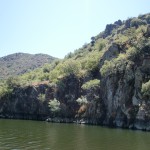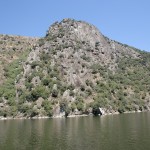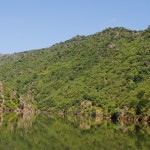Located in the provinces of Salamanca y Zamora (Castile and León), Arribes del Duero Natural Park forms what is known as the line of Portugal. It covers 106.105 ha and the region is linked to boxing the Douro River in granite, a deep cut that has been drilled over millions of years by rivers and streams that converge to give rise to a landscape of canyons and cut up 400 m high.
Due to this gap has been generated a Mediterranean microclimate, warmer than the adjacent area. This has been exploited by man for cultivation of other rare species in these latitudes (olive, almond, cherry, grapes …) with terracing on the slopes in order to maximize the ground, accompanied by a rich vegetation of ashes, willows and hackberry trees nearby. Special mention to the forest of hackberry trees in Mieza (Salamanca), the largest in Europe.
In the peneplain, between 500 and 700 meters, there are two formations: Rebollares in wetter environments and oak groves, which replaced in drier areas. The livestock use has changed, in many cases, the original structure of local tree until to transform them into existing pasture area. Despite this reduction, at least 106 species that are associated with the crag and the surrounding meadows acid substrate are preserved.
As for fauna, there are registered more than three hundred species of vertebrates. Among which these are the black stork, Bonelli’s eagle, the vulture, the griffon vulture, golden eagle, peregrine falcon and the eagle owl. In addition, it should be mentioned the existence of a player Dupont’s lark, the westernmost of the Iberian Peninsula.
As for the Portuguese side (Douro International Natural Park), this extends for about 120 kilometers in a relatively narrow strip of territory along the international sections of the Douro River and its tributary Águeda. Much of this area corresponds to strong river canyon rocky and steep slopes, ecologically associated with the wide plateau flanking it. The transition between 600 and 800-meter drop from the plateau to the bottom of the Arribes is steeper in the north, while gentle slopes perform the south. Granites predominate north and south.
Forest occupies nearly half the area of the sites where the bushes predominate. The plateau is an area of small farms, with Atlantic climate, characterized by extensive dry farming, predominantly associated with the production of grain and fodder for livestock. The relief is softer in these areas, which are intensively cultivated and grazed. They are great floristic areas without interest, except in some places where we can find some Lameiros with high floristic diversity.
It is an area with great floristic interest and islands of vegetation in very good condition, with emphasis on those that occupy the cliffs, where thermophilic areas with populations of more important juniper Portugal appear.
Agriculture in mosaic, with relatively high primary productivity, represents a fundamental source of energy for many species of wildlife that find refuge in the rugged area of the river, particularly the avifauna.






